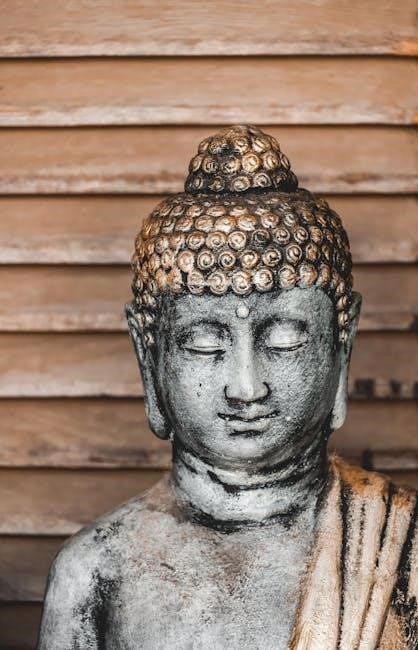Eugen Herrigel’s Zen in the Art of Archery is a profound exploration of Zen philosophy through the practice of Kyudo. The book recounts Herrigel’s six-year journey studying archery under Japanese Zen masters, revealing insights into mastery, discipline, and mindfulness.
1.1 Overview of the Book
Zen in the Art of Archery is a captivating blend of personal narrative and philosophical inquiry. Eugen Herrigel recounts his six-year journey mastering Kyudo under Japanese Zen masters, offering a unique perspective on the intersection of Zen Buddhism and archery. The book explores themes of discipline, mindfulness, and the pursuit of mastery, while challenging Western notions of technique and ego. Through his experiences, Herrigel illuminates the spiritual dimensions of archery, presenting it as a path to self-discovery and inner harmony. This timeless work has become a cornerstone of Eastern philosophy, inspiring readers to explore the deeper meaning of art and practice.
1.2 The Author: Eugen Herrigel
Eugen Herrigel was a German philosopher and professor who settled in Tokyo during the 1920s. Intrigued by Zen Buddhism, he sought to understand it through the practice of Kyudo, traditional Japanese archery. His experiences formed the basis of Zen in the Art of Archery, which bridged Eastern philosophy with Western audiences. Herrigel’s unique perspective as an outsider allowed him to capture the essence of Zen in a relatable manner, making the book a seminal work in cross-cultural understanding. His journey reflects a deep commitment to learning and self-discovery, offering timeless insights into the nature of mastery and spirituality.
1.3 The Intersection of Zen and Archery
Zen Buddhism and archery converge in the concept of “artless art,” where technical mastery transcends conscious effort. The book explores how Kyudo embodies Zen principles, emphasizing mindfulness, focus, and the dissolution of the ego. Archery becomes a meditation, where the archer’s awareness merges with the act, reflecting the Zen ideal of “suchness” or being fully present. Herrigel illustrates how the pursuit of perfection in archery mirrors the Zen journey of self-discovery, highlighting the importance of discipline and letting go. This intersection transforms archery into a spiritual practice, revealing the deeper truths of existence through the simplicity of the shot.
The Historical and Cultural Context
Kyudo, or traditional Japanese archery, has ancient origins, evolving from a martial art to a spiritual practice deeply influenced by Zen Buddhism, emphasizing mindfulness and focus.
2.1 Kyudo: The Traditional Japanese Archery
Kyudo, or traditional Japanese archery, is an ancient martial art with roots in Shinto and Zen Buddhism. Evolving from a practical skill to a meditative practice, it emphasizes harmony between archer, bow, and target. The art form, deeply rooted in Japanese culture, teaches balance, focus, and self-awareness. Practitioners aim to transcend technique, achieving an “artless art” where the act of shooting becomes intuitive. This discipline reflects Zen principles, fostering mindfulness and unity with nature. Through its rituals and philosophy, Kyudo embodies the spiritual essence of Japan, offering a path to inner peace and self-discovery.
2.2 Zen Buddhism and Its Influence on Japanese Culture
Zen Buddhism has profoundly shaped Japanese culture, emphasizing mindfulness, simplicity, and the pursuit of inner peace. Its principles permeate various arts, from calligraphy to tea ceremonies, fostering a deeper connection to nature and life. Zen’s concept of “suchness” (tathatā) encourages seeing reality as it truly is, influencing aesthetics and philosophy. The integration of Zen into daily life and martial arts reflects its enduring impact, promoting mental and spiritual balance. This cultural synthesis is central to understanding the spiritual dimensions of practices like Kyudo, where archery becomes a meditative act embodying Zen’s timeless teachings.
2.3 The Role of Archery in Zen Practice
Archery in Zen practice serves as a medium for spiritual growth, transcending mere technical skill. It embodies the pursuit of mindfulness, discipline, and self-awareness. The act of drawing the bow and releasing the arrow becomes a meditation, requiring focus and harmony between body and mind. Zen archery teaches the paradox of intention and detachment, where the archer must let go of the need to hit the target. This practice cultivates a state of “suchness” (tathatā), where the archer becomes one with the moment, freeing the mind from dualistic thinking. Through this, archery becomes a path to enlightenment, reflecting Zen’s essence of simplicity and profundity.

Key Concepts Explored in the Book
The book explores Zen principles like the “artless art,” the unconscious mind’s role in mastery, and the balance between discipline and spontaneity in achieving perfection.
3.1 The Philosophy of “Artless Art”
The concept of “artless art” in Zen in the Art of Archery signifies transcending technique to achieve effortless mastery. Herrigel learns that true artistry arises when the archer becomes one with the bow, arrow, and target, moving beyond conscious effort. This philosophy emphasizes harmony between body and mind, where actions flow naturally without deliberate thought. The “artless art” represents a state of pure being, free from ego and intention, reflecting Zen’s essence of simplicity and spontaneity. Through this principle, Herrigel illustrates the paradox of achieving perfection by letting go of control.
3.2 The Concept of the “Unconscious” in Archery
In Zen in the Art of Archery, the “unconscious” refers to a state where the archer acts without deliberate thought, allowing the shot to unfold naturally. This concept, central to Zen, suggests that true mastery occurs when the archer transcends conscious control, letting the body perform instinctively. Herrigel learns that the unconscious is not a lack of awareness but a heightened state of unity with the task. By surrendering ego and intellectual interference, the archer achieves harmony between body and mind, embodying the Zen principle of effortless action. This paradox of control and release is key to understanding the book’s teachings on mastery.
3.3 The Relationship Between Discipline and Mastery
In Zen in the Art of Archery, discipline is the cornerstone of mastery. Herrigel learns that mastery is not achieved through talent or intuition alone but through rigorous, consistent practice. The Zen master emphasizes repetition and adherence to technique, teaching that true mastery emerges when the archer surrenders to the process. This discipline mirrors Zen principles, where self-control and patience are essential for spiritual growth. Through relentless training, the archer transcends conscious effort, achieving a state where technique and intention merge seamlessly. This journey reflects the Zen philosophy that mastery is a lifelong path of dedication and surrender.
The Practice of Archery as a Zen Discipline
Kyudo, or Japanese archery, is a meditative practice blending physical technique with mental discipline. Archers train to merge body and mind, fostering mindfulness and spiritual growth through repetition.
4.1 The Technical Aspects of Kyudo
Kyudo, the traditional Japanese archery, emphasizes precise techniques passed through centuries. The process involves mastering the bow’s grip, arrow placement, and the movement of the hiku, the drawing hand. Archers train in seven basic shooting forms, focusing on harmony and balance. The bow, crafted from bamboo or carbon fiber, symbolizes simplicity and strength. Proper posture and breathing are crucial, aligning the body for optimal accuracy. Each shot requires attention to form, ensuring the arrow flies straight and true, reflecting both technical skill and mental clarity. This technical mastery is the foundation for Kyudo’s deeper spiritual dimensions.
4.2 The Spiritual Dimensions of the Practice
Beyond its technical aspects, Kyudo embodies profound spiritual dimensions rooted in Zen Buddhism. The practice transcends archery, becoming a meditation on harmony and self-discovery. Archers seek to unify body and mind, letting go of ego and distractions. Each shot is a moment of mindfulness, aiming not just at the target but at inner clarity; The process of drawing and releasing the arrow mirrors life’s fleeting nature, teaching patience and detachment. Through relentless practice, archers cultivate a state of “mushin,” or no-mind, where action flows effortlessly from intention. This spiritual journey transforms Kyudo into a path of self-realization and enlightenment.

4.3 The Role of the Teacher-Student Relationship
The teacher-student relationship in Kyudo is sacred, mirroring the traditional Zen master-disciple dynamic. The master guides the student beyond technical proficiency, fostering spiritual growth and self-awareness. Herrigel’s journey highlights the patience and wisdom of his teacher, who emphasized harmony between mind and body. The teacher’s role is to correct form, offer cryptic insights, and push the student toward enlightenment. This relationship is built on trust, discipline, and mutual respect, allowing the student to transcend ego and embrace the true essence of Zen. The master’s presence is both nurturing and challenging, facilitating the student’s journey toward mastery and inner peace.

Psychological and Philosophical Insights
Zen in the Art of Archery offers profound psychological insights, exploring the ego’s role in archery and the process of overcoming mental barriers through mindfulness and focus.
5.1 The Role of Ego in Archery and Zen
The ego plays a significant role in both archery and Zen, often acting as a barrier to true mastery. Herrigel’s journey reveals how the ego’s desire to control and achieve perfection hinders the natural flow of the practice. Zen teachings emphasize the importance of letting go of self-consciousness and the need to hit the target. By releasing the ego, the archer can align with the natural order, allowing the shot to occur effortlessly. This spiritual principle transcends archery, offering insights into overcoming ego-driven limitations in all aspects of life.
5.2 The Process of Overcoming Initial Inhibitions
Herrigel’s journey begins with frustration, as his Western mindset and ego clash with the Zen approach to archery. His initial struggles stem from self-consciousness and a focus on technique, which hinder his progress. Through patient guidance from his master, he learns to let go of these inhibitions, embracing a more intuitive and meditative approach. The process involves surrendering the need for immediate results and instead cultivating awareness and harmony with the practice. This transformation mirrors Zen teachings, where overcoming initial resistance leads to a deeper understanding of both archery and oneself.
5.3 The Importance of Mindfulness and Focus
Mindfulness and focus are central to the Zen practice of archery, as described in Herrigel’s journey. The archer must cultivate a state of complete awareness, letting go of distractions and self-consciousness. Focus is not merely on the target but on the process itself, allowing the archer to transcend technique and achieve harmony. This mindfulness enables the archer to align body and mind, creating a seamless flow of action. By immersing oneself in the present moment, the practice becomes a meditation, fostering inner peace and clarity; Herrigel’s experiences illustrate how mindfulness transforms archery into a deeply spiritual and fulfilling discipline.

The Author’s Personal Journey
Eugen Herrigel’s six-year study of archery in Japan aimed to understand Zen Buddhism. His journey reveals struggles, breakthroughs, and the evolution of his Zen comprehension.
6.1 Herrigel’s Six-Year Study of Archery
Herrigel immersed himself in Kyudo under esteemed Japanese masters. His six-year journey was marked by rigorous training, blending technical mastery with spiritual growth. Initially, he faced challenges in harmonizing body and mind, reflecting common struggles in Zen practice. Through perseverance, he gradually transcended ego and technique, embodying the artless art. This period of intense dedication laid the foundation for his profound insights into Zen.
6.2 His Struggles and Breakthroughs in Zen Practice
Herrigel’s journey was marked by significant struggles as he grappled with the fusion of technique and spirituality. Initially, he found it difficult to reconcile the physical act of archery with the mental discipline of Zen. His instructors emphasized the importance of letting go of self-consciousness, a concept that challenged his Western mindset. Through persistent practice, Herrigel experienced breakthroughs, particularly in understanding the role of the “unconscious” in archery. He learned to transcend technique, achieving a state where the bow, arrow, and shooter became one.
6.3 How His Understanding of Zen Evolved
Herrigel’s understanding of Zen transformed profoundly during his six-year study. Initially, he viewed Zen as a mysterious, esoteric philosophy separate from archery. Through rigorous practice, he realized Zen was not just a mental state but an embodied experience. His teachers emphasized mindfulness, presence, and the dissolution of the ego. Over time, Herrigel moved beyond technical mastery, grasping the essence of Zen as a harmonious balance between body and mind; His evolving insight revealed Zen as a universal principle, applicable far beyond archery, illuminating life itself with clarity and simplicity.

The Legacy and Impact of the Book
Eugen Herrigel’s Zen in the Art of Archery became a landmark work, introducing Zen philosophy to Western audiences and sparking widespread interest in Eastern spirituality and martial arts.
7.1 The Book’s Influence on Western Understanding of Zen
Eugen Herrigel’s Zen in the Art of Archery played a pivotal role in popularizing Zen Buddhism in the West. By blending the disciplines of archery and Zen, the book provided a unique lens through which Western readers could understand the principles of mindfulness, self-discipline, and the pursuit of mastery. Its accessible narrative and deep insights demystified Zen, making it relatable and intriguing to a broad audience. This influence extended beyond philosophy, inspiring applications of Zen principles in sports, arts, and daily life, fostering a cultural bridge between Eastern traditions and Western curiosity.
7.2 Criticisms and Controversies Surrounding the Book
Eugen Herrigel’s Zen in the Art of Archery has faced criticism for its cultural and historical interpretations. Some scholars argue that Herrigel romanticized Zen and overlooked the complexities of Japanese culture, reducing it to simplistic or misleading representations; Additionally, his portrayal of archery as a solely Zen practice has been disputed, as Kyudo has roots in Shinto and Bushido traditions. Critics also highlight Herrigel’s association with Nazi ideology, questioning the ethical implications of his work. These controversies have sparked debates about the book’s accuracy and its influence on Western perceptions of Zen and Japanese culture.
7.3 Its Influence on Modern Archery and Zen Practices
Eugen Herrigel’s Zen in the Art of Archery has significantly influenced modern archery and Zen practices. The book introduced Zen principles to Western audiences, inspiring the integration of mindfulness and meditation into archery training. Many contemporary archers now incorporate Zen techniques to enhance focus and mental clarity. Additionally, the book has shaped the global perception of Kyudo, encouraging its practice beyond Japan. Its emphasis on the unity of body and mind has also inspired cross-disciplinary applications, making it a cornerstone in both Zen and archery communities, fostering a deeper understanding of the interplay between physical discipline and spiritual growth.

The Relevance of Zen in Modern Archery
Zen principles remain vital in modern archery, fostering focus, clarity, and mental discipline. Archers apply these teachings to enhance performance, transforming the sport into a meditative practice.
8.1 How Zen Principles Apply to Contemporary Archery
Zen principles like mindfulness and focus are integral to contemporary archery, helping archers maintain concentration and clarity. These teachings emphasize being fully present in the moment, aligning body and mind to achieve precision. By letting go of distractions and ego, archers can transcend technical limitations, fostering a deeper connection between the act of shooting and inner peace. This harmonious blend of physical skill and mental discipline allows modern archers to embrace the art form as a holistic practice, much like their traditional counterparts.
8.2 The Role of Meditation in Modern Archery Training
Meditation plays a crucial role in modern archery training by cultivating mental clarity and focus. Archers use mindfulness practices to quiet the mind, reducing anxiety and improving concentration. This mental discipline, rooted in Zen teachings, helps archers maintain composure under pressure. Regular meditation enhances spatial awareness and emotional stability, allowing for more precise shots. By integrating meditation into their regimen, modern archers align with the traditional Zen approach, fostering a harmonious balance between body and mind. This practice not only elevates performance but also enriches the archer’s mental and emotional well-being, embodying the holistic nature of Zen in archery.
8.3 The Benefits of Zen Practice for Archers
Zen practice offers archers profound benefits, enhancing mental clarity, focus, and emotional stability. By cultivating mindfulness, archers achieve greater accuracy and consistency in their shots. Zen helps manage pressure and maintain composure, essential for high-stakes competitions. The discipline fosters a deeper connection between body and mind, allowing archers to perform intuitively. Regular Zen practice also builds resilience, enabling archers to bounce back from setbacks. Beyond performance, Zen nurtures overall well-being, promoting a sense of calm and self-awareness. As Eugen Herrigel noted, Zen practice transforms archery into a meditation, making it a holistic pursuit of mastery and inner peace.

The Broader Applications of Zen Principles
Zen principles extend beyond archery, influencing sports, daily life, and work through mindfulness, discipline, and presence. Their universal appeal fosters personal growth and harmony in all activities.
9.1 Zen in Sports and Physical Activities
Zen principles enhance athletic performance by fostering mindfulness and focus. Athletes adopt meditation and breathing techniques to cultivate mental clarity, reducing pressure and improving concentration. This approach, inspired by Kyudo, teaches harmonizing body and mind, enabling peak performance. By transcending ego and technique, athletes achieve fluidity in motion, mirroring the “artless art” described in Zen in the Art of Archery. This philosophy is widely applied in sports, promoting a holistic approach to training and competition, emphasizing inner balance as key to excellence.
9.2 Zen in Daily Life and Work
Zen principles from Zen in the Art of Archery offer practical wisdom for daily life and work. By embracing mindfulness and balance, individuals can transcend ego and distractions, fostering clarity and focus. Herrigel’s insights reveal how the “artless art” of Zen allows one to flow effortlessly through tasks, whether professional or personal. This approach encourages harmony between body and mind, promoting efficiency and calm. In work, Zen practices enhance productivity by reducing stress and increasing concentration, while in daily life, they cultivate contentment and fulfillment, reflecting the timeless wisdom of Herrigel’s journey with Kyudo.
9.3 The Universality of Zen Teachings
Zen teachings transcend cultural boundaries, offering universal truths applicable to all aspects of life. As explored in Zen in the Art of Archery, the essence of Zen lies in its simplicity and timelessness, making it accessible to anyone, regardless of background. Herrigel’s journey illustrates how Zen’s core principles—mindfulness, self-discipline, and the pursuit of mastery—are not confined to archery or Eastern traditions but resonate globally. These teachings inspire personal growth, fostering a deeper understanding of oneself and the world. Their universal appeal ensures Zen remains a vital philosophy for modern global audiences seeking balance and harmony in an ever-changing world.
Zen in the Art of Archery masterfully blends Zen philosophy with archery, offering timeless insights into mastery, mindfulness, and self-discovery. Herrigel’s journey remains a universal inspiration, encouraging readers to embrace Zen principles in their own paths toward balance and harmony.
10.1 Summary of Key Takeaways
Zen in the Art of Archery offers profound insights into the fusion of Zen philosophy and archery, emphasizing the importance of mindfulness, discipline, and transcendence of the ego. Herrigel’s journey reveals how archery becomes a metaphor for life, teaching the value of surrendering to the process rather than focusing on results. The book underscores the role of the unconscious in mastery, highlighting how technique must become second nature. Through his experiences, Herrigel illustrates the universal truths of Zen, showing how its principles can guide individuals toward self-discovery and harmony in both physical and mental pursuits.
10.2 The Timeless Appeal of “Zen in the Art of Archery”
The timeless appeal of Zen in the Art of Archery lies in its universal themes of mindfulness, discipline, and self-discovery. Herrigel’s account transcends archery, offering insights into the human condition and the pursuit of mastery. The book’s exploration of Zen principles resonates across cultures, making it a cherished read for philosophers, practitioners, and anyone seeking personal growth. Its enduring popularity stems from its ability to bridge Eastern philosophy with Western curiosity, providing a unique lens through which to view life’s challenges and the journey toward inner harmony. The book remains a vital resource for understanding Zen’s practical applications.
10.3 Encouragement to Explore Zen and Archery
Herrigel’s narrative inspires readers to explore Zen and archery as complementary paths to self-discovery. By bridging Eastern philosophy with Western curiosity, the book invites individuals to embrace mindfulness, discipline, and the pursuit of mastery. Archery, as depicted, becomes a metaphor for life’s challenges, urging practitioners to let go of ego and align with the present moment. The book encourages a deeper understanding of Zen’s universal teachings, offering practical insights for personal growth. Whether through archery or daily life, Herrigel’s journey motivates readers to seek harmony and fulfillment by integrating Zen principles into their experiences.